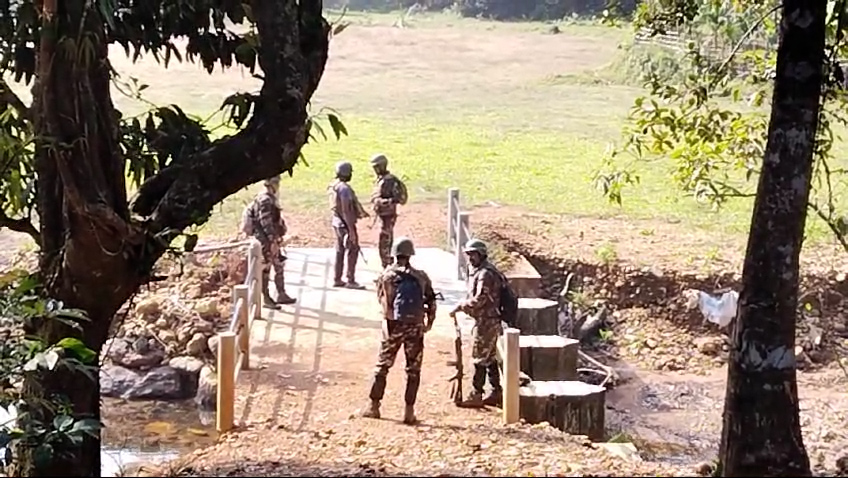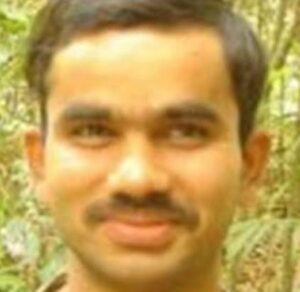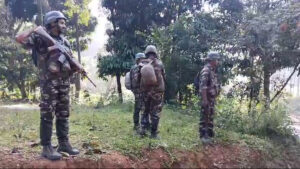The encounter on 18 November, the first significant exchange of gunfire between the Karnataka police and Naxals in the Coastal region in 13 years, signalled the presence of an active Naxal movement in the area.
Published Nov 25, 2024 | 11:00 AM ⚊ Updated Nov 26, 2024 | 9:15 AM

Anti Naxal Force combing in the Kabbinele Forest area in Hebri at Udupi taluka. (supplied)
In a dramatic showdown deep within the dense Kabbinale forest of Hebri taluka in Udupi district, the Karnataka Anti-Naxal Force (ANF) ended a two-decade-long pursuit. They eliminated Kabini Dala’s Naxal commander Vikram Gowda — one of the state’s most wanted Naxal commanders.
This encounter on 18 November, the first significant exchange of gunfire between the police and Naxals in the Coastal region in 13 years, signalled the presence of an active Naxal movement in the area.
While the operation marked a significant victory for the Karnataka Police, it also underscored the ongoing challenge for law enforcement, as several Naxal operatives continue to remain underground, continuing their efforts to destabilise the region.
According to state police sources, ANF remains resolute in its mission, intensifying its hunt to dismantle the remnants of the insurgent network and restore peace in affected areas in the coastal area.
Former Naxalites have strongly condemned the police action against Vikram Gowda, calling for a thorough investigation into the encounter that sent shockwaves among active Naxal groups in the region.
Naxal activities are not a new phenomenon in Karnataka. It has been grappling with the state coupled with Maoist insurgency for several decades now. Over the years, the state has successfully neutralised many prominent Naxal leaders, Vikram Gowda being the latest on this list.
The name Vikram Gowda evokes fear, sparks controversy, and arouses intrigue in the forest areas of Karnataka which are plagued with Naxal presence.
Once a quiet tribal youth from Nadpal village in Hebri taluka in Udupi district, Vikram’s journey from an impoverished childhood to becoming one of the most-wanted Naxalites in Karnataka, Kerala and Tamil Nadu is a tale of desperation, rebellion, and relentless pursuit by law enforcement.
Born to Venkayya Gowda and Gulabi Gowda, Vikram was the eldest of four siblings in a family belonging to the Malekudiya tribal community.

Vikram Gowda was killed in an encounter by Anti Naxal Force at Hebri on 18 November. (supplied)
Poverty defined his early life. With less than half an acre of land — just 14 guntas — his family struggled to survive. Forced to drop out of school after Class 4, Vikram moved to Mumbai in search of work and spent several years as a waiter in a hotel. By the late 1990s, he returned to his hometown, hoping to build a life closer to his roots.
However, life in Nadpal was not easier. The Kudremukh National Park Project, aimed at conserving forest land, turned into a nightmare for tribal families like Vikram’s. When the government issued eviction notices to his family, the young man found himself thrust into the heart of the resistance movement.
Between 1998 and 2003, Vikram became an active participant in protests organised by the Karnataka Vimochana Ranga, which later emerged as a Maoist faction under the leadership of Saket Rajan, opposing the project that threatened to uproot his community.
However, the price of dissent was high. Vikram and his family reportedly aced constant harassment from forest and police officials. The situation escalated after the 2003 police encounter that killed Naxalite fighters Parvathi and Hajima near Hebri, which was the first reported Naxal encounter in Karnataka.
Vikram was repeatedly detained, tortured, and accused of connections to the Maoist movement. With no path to a peaceful life in sight, Vikram crossed the line from protester to insurgent, becoming an ordinary member of a Naxalite faction and then leading different groups including Kabini Dala.
Active Naxals Sundari, Vanajakshi, Mundagaru Latha, Kote Hunde Ravindra, Jayanna (also known as John), and Ramesh are followers of Vikram Gowda, who was heading the Kabini Dala. In the last two decades, these Maoist followers have been hiding in the jungles of Karnataka, Kerala and Tamil Nadu.
Over the years, Vikram’s name became synonymous with rebellion. Vikram was booked in 114 cases across Karnataka, Tamil Nadu and Kerala.
In Karnataka alone, he faced 61 cases, with 34 in Udupi district, 12 in Chikkamagaluru, and others spread across Shivamogga, Hassan, and Dakshina Kannada. Kerala charged him in 19 cases. The charges against him include murder, violations of the Unlawful Activities (Prevention) Act, 1967, and the Arms Act.
Vikram’s ability to evade capture has added to his notoriety. In 2013, under the leadership of senior IPS officer Alok Kumar, the Anti-Naxal Force came close to apprehending him three times, but he managed to slip away each time.
Since then, he had remained elusive, disappearing into the forests that became his refuge and battleground. Karnataka Police had also announced ₹5 lakh reward, whereas Kerala announced ₹25 lakh for sharing the whereabouts of several active Naxalites, including Vikram Gowda.
After two decades of evading capture, the Karnataka ANF eliminated Vikram Gowda in an operation conducted in the Kabbinale forest range of Hebri taluka at Udupi district on 18 November.
A case has been registered at Hebri Police Station based on a complaint filed by ANF’s Deputy Superintendent of Police (DySP) Raghavendra Nayak.
The ANF personnel had intensified combing operations in the Malnad and Coastal areas following reports of suspected Naxal movements in the region since February-March, 2024.

Anti Naxal Force has intensified combing to find the remaining Naxals in Malnad and Coastal area. (supplied)
According to FIR: “Acting on a tip-off that three to four Naxals, who members of the banned militant CPI (Maoist) organisation, would arrive near Nadpal village to collect rations, the ANF laid a trap to apprehend Vikram Gowda, who had eluded authorities for over two decades.”
“As expected, around three to four Naxals, including Vikram Gowda, arrived at the location on 18 November. The ANF personnel, upon spotting them, urged them to surrender peacefully.”
“However, the Naxals reportedly opened fire on the police (ANF). In- self-defence, the police retaliated. In the ensuing exchange of gunfire, Vikram Gowda was killed, while the others managed to escape into the forest,” mentioned in the FIR.
The other suspects under scrutiny for alleged Naxal activities include Sundari, Vanajakshi, Mundagaru Latha, Kote Hunde Ravindra, Jayanna (also known as John), and Ramesh, claimed sources in the police department.
Inspector General (Internal Security) D Roopa Moudgil told South First: “Karnataka is blessed not to have major problems. The Naxal problem has been there since 2005. This Naxal who died in the encounter was active in the trijunction forest of Karnataka, Tamil Nadu and Kerala.”
“It’s a teamwork with quite a hand holding by DG ISD [Internal Security Division] Pranab Mohanty, to whom ANF reports. I head Operations under ISD and holding charge of ANF commander. Hands-on the team was led by ANF SP Jitendra Dayama,” added Roopa.
“Vikram Gowda was the ringleader of the South India Naxal gang. He had 61 cases of murder, extortion, Arms Act cases against him in Karnataka and about 19 cases in Kerala and Tamil Nadu,” elaborated the IGP Internal Security.
The Naxal movement in Karnataka resurfaced recently following the arrest of the most wanted Naxal Suresh Angadi by Kerala’s ANF in February 2024.
On anonymity, the senior police officer associated with ANF told South First: “The resurgence of Naxal activity in Karnataka came to light after Kerala’s ANF apprehended Suresh Angadi, a wanted Naxalite from Chikkamagaluru, in February 2024. These Naxals had been hiding in the dense forests spanning Karnataka and Kerala for years.”
“During interrogation, Angadi provided crucial information about their activities and frequent visits to three houses in the Kabbinale forest area, which prompted us to intensify combing operations in the vulnerable Malnad and Coastal regions. We had tried to reach them (to speak) but couldn’t connect to any of them.”
“On 18 November, the Naxals arrived as expected. Despite being urged to surrender, they opened fire, prompting police to retaliate in self-defence. Vikram Gowda was killed on the spot, while the others escaped. We are continuing operations to apprehend the remaining members,” stated the police officer.
While former Naxalites claimed that the Naxal movement started because of the fight against the feudal system, Karnataka former Director General & Inspector of Police (DG&IGP) Dr ST Ramesh highlighted that the left-wing extremism has been extended to the South from Chhattisgarh.
Ramesh told South First: “Karnataka is not considered a Naxal prone or Naxal affected area unlike Chhattisgarh or Madhya Pradesh or Odisha, which are densely forested and tribal areas”
“Since Left-wing extremists want to extend their areas of operation, they have got their plans to go beyond these traditional areas, extending till Kerala. By this plan, they have made inroads into the south as well,” added the former police officer.
Pointing at Naxal activities in Karnataka, he said: “In Karkala, and Malnad areas, there are tribal pockets. They are known by the name Malekudiyas. The left-wing extremists made Malnad areas their hideout and started Naxalite activities there. It has been going on in a very dormant fashion.”
He continued: “Their plan is to carve out a ‘Red corridor’ through the Dandakaranya forests which is an old plan and that has not changed. They have formed Dalams (area of operation) in different places.”
“They have also given a name to this Karnataka unit and got a head for each one of them. The head will be somebody with knowledge of local geography, culture and language,” the former police officer said.
Since the early 2000s, Karnataka reported several Naxal activities, causing damage to life and public properties. These incidents include the bombing of a police jeep in Hebri’s Kabbinale in 2005, the death of Sub-Inspector (SI) Venkatesh near Agumbe in 2007, and the murders of Bhoja Shetty and his relative Sadashiva Shetty near Nadpalu in 2008.
In a press statement, now reformed and returned to mainstream, Noor Sridhar and Sirimane Nagaraj, who bid adieu to the Maoist activities since 2014, stated: “The Naxal movement in India, born as a rebellion against the feudal landlord system. For the last 67 years, this movement has persisted across various parts of the country, including Karnataka.”
“Since 1987, efforts were made to establish an armed struggle in Karnataka, but the experience has revealed profound lessons,” added Noor and Nagaraj.
The duo recalled: “Initial attempts in the Hyderabad-Karnataka region failed miserably, compelling a shift to the Malnad region. Despite these setbacks, many of us argued that it was time to reevaluate the strategy and seek a new path forward.”
“We firmly believed that instead of perpetuating the armed struggle, the need of the hour was to build a broad-based people’s movement. This approach would unite all progressive forces to challenge the rulers, condemn their anti-people policies, and spearhead meaningful change,” pointed out Noor and Nagaraj.
They continued: “Unfortunately, the Maoist leadership remained inflexible, clinging to an outdated strategy of armed struggle. This dogmatic adherence to a failed path has led to the loss of countless lives, including dedicated leaders like Saket Rajan. The recent tragic death of Vikram Gowda is another grim reminder of the toll this misguided approach continues to exact.”
Ramesh pointed out that poverty, inequality and injustice are at the bottom of the Naxalite movement.
“Poverty, inequality and injustice are responsible for Naxalite movement. Naxals are those citizens who feel furious with the system and injustice that happens in our society, especially inequalities and poverty.”
“Poor people continue to remain poor and rich people get richer -this phenomenon is at the bottom of this Naxalite activity. Naxalites believe in Mao Tse Tung’s philosophy, ‘Power flows from the barrel of the gun’, They follow and believe in this motto,” the former police officer added.
“They believe in the ideology that through violence they should bring down elected governments and establish one which will be pro-poor.”
“In the process, they brainwash their targets, those who are vulnerable. Poor people who have faced injustice fall easy prey to Left-wing extremism. They will only target poor people. In the case of Vikram Gowda, he was a waiter in a small restaurant (in Mumbai).”
“They take advantage of the poverty, injustice and inequality of those victims. They target such people and recruit them. They may show them a bright future, with the hope that one day they will be able to succeed in achieving their goals,” elaborated the former police officer.
Ramesh said that once the entry was made into Naxalism, it was difficult to get out of it.
“Once they are compromised, they get into their (Naxals) network. And then on, it becomes difficult for them to get out even if they want to,” he said.
“A lot of people who get into the Naxalite movement and then feel frustrated because the reality of life as a Left-wing extremist may be different from what they might have imagined or they were made to believe”.
“Life in the forest and hiding is not an easy thing. They may get disillusioned soon. But once you are in, it is difficult to come out. The commanders may use all methods to retain the recruits. They will resort to all methods to retain,” pointed out the former police officer.
(Edited by Muhammed Fazil)
